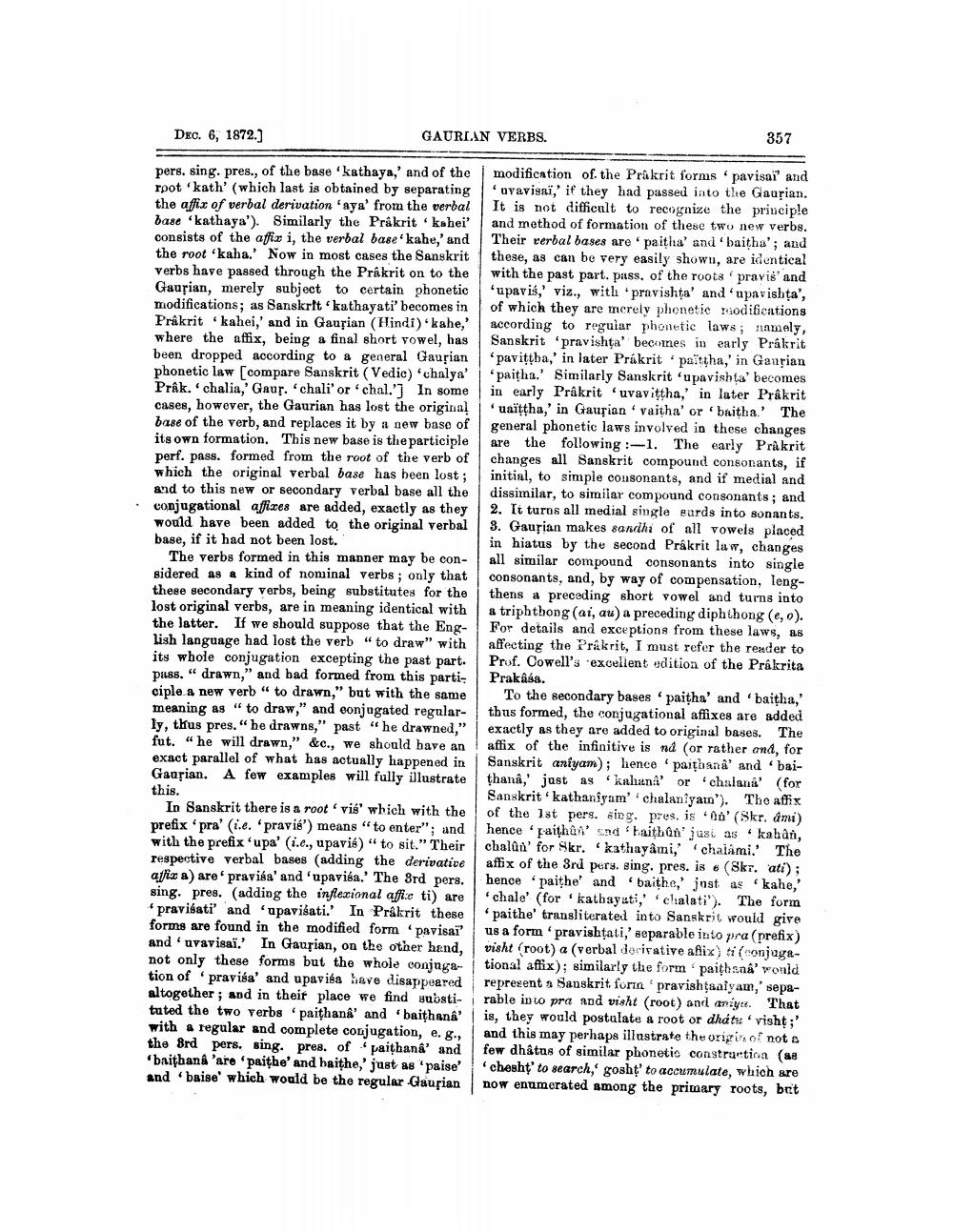________________
Dec. 6, 1872.]
GAURLAN VERBS.
357
pers. sing. pres., of the base 'kathaya,' and of the modification of the Prakrit forms pavisai' and rpot 'kath' (which last is obtained by separating 'oyavigai,' if they had passed into the Gausian. the affix of verbal derivation 'aya' from the verbal It is not difficult to recognize the principle base 'kathaya'). Similarly the Prakrit kahei' and method of formation of these two new verbs. consists of the affix i, the verbal base kahe,' and Their rerbal bases are paitha' and 'baitha'; and the root 'kaha.' Now in most cases the Sanskrit these, as can be very easily show, are identical verbs have passed through the Prakrit on to the with the past part. pass, of the roots 'pravis' and Gaupian, merely subject to certain phonetic "upavis,' viz., with pravishta' and 'upavishta', modifications; as Sanskrit 'kathayati' becomes in of which they are merely phenetie modifications Prakrit kahei,' and in Gausian (Hindi) kahe,' according to regular phonetic laws; namely, where the affix, being a final short vowel, has Sanskrit pravishta' becomes in early Prakrit been dropped according to a general Gaurian pavitha,' in later Prakrit paitsha,' in Gaurian phonetic law [compare Sanskrit (Vedic) 'chalya' i 'paitha.' Similarly Sanskrit ‘upavishta' becomes Prâk. chalia, Gaur. chali' or 'chal.') In some in early Prakrit 'uvavittha,' in later Prakrit cases, however, the Gaurian has lost the original uaïţtha,' in Gausian vaitha' or 'baitha.' The base of the verb, and replaces it by a new base of general phonetic laws involved in these changes its own formation. This new base is the participle are the following:-1. The early Prakrit perf. pass. formed from the root of the verb of changes all Sanskrit compound consonants, if which the original verbal base has been lost; initial, to simple consonants, and if medial and and to this new or secondary verbal base all the dissimilar, to similar compound consonants; and conjugational affixes are added, exactly as they 2. It turns all medial single eards into sonants. would have been added to the original verbal 3. Gausian makes sandhi of all vowels placed base, if it had not been lost.
in hiatus by the second Prakrit law, changes The verbs formed in this manner may be con- all similar compound consonants into single sidered as a kind of nominal verbs; only that consonants, and, by way of compensation, lengthese secondary verbs, being substitutes for the thens a preceding short vowel and turns into lost original verbs, are in meaning identical with a triphthong (ai, au) a preceding diphthong (e, o). the latter. If we should suppose that the Eng- For details and exceptions from these laws, as lish language had lost the verb “to draw" with affecting the Prakrit, I must refer the reader to its whole conjugation excepting the past part. Prof. Cowell's 'excellent edition of the Prakrita Piss. " drawn," and bad formed from this parti Prakasa. ciple a new verb "to drawn," but with the same To the secondary bases paitha' and 'baitha,' meaning as "to draw," and conjugated regular- thus formed, the conjugational affixes are added ly, thus pres." he drawns," past "he drawned," exactly as they are added to original bases. The fut. "he will drawn," &c., we should have an affix of the infinitive is nd (or rather and, for exact parallel of what has actually happened in Sanskrit aniyam); hence paithana' and baiGaasian. A few examples will fully illustrate thanâ,' just as "kahana' or 'chalana' (for this.
Sanskrit kathaniyam'chalaniyan'). The affix In Sanskrit there is a root vis' which with the of the 1st pers. sing. pres. is 00' (Skr, ami) prefix pra' (.e. pravis') means "to enter"; and hence paithanand baithan jusi as kahan, with the prefix*upa' (i.c., upavis) “to sit.” Their chalan' for Skr. kathayâmi,' chalami.' The respective verbal bases (adding the derivative affix of the 3rd pers. sing. pres. is . (Bkz. ati); affia a) are praviša' and 'upavisa.' The 3rd pers. hence paithe' and baithe, just as kahe,' sing. pres. (adding the inflexional affic ti) are chale' (for katbayati, chalati). The form
pravisati' and 'upavisati.' In Prakrit these paithe' transliterated into Sanskrit would give forms are found in the modified form pavisai' us a form pravishtati,' separable into pra (prefix) anduvavisaï.' In Gaurian, on the other hand, visht (root) a (verbal derivative aflix) ti(conjugenot only these forms but the whole conjuga- tional affix); similarly the form paithana' would tion of pravisa' and upavisa have disappeared reprezent a Sanskrit forma pravishtaniyam,' sepaaltogether; and in their place we find substi- i rable into pra and visht (root) and aniya. That tuted the two verbs paithana' and 'baithana' | is, they would postulate & root or dháta visht;' with a regular and complete conjugation, e. 8., and this may perhaps illustrate the origin of not the Brd pers. sing. pres. of paithana' and few dhâtus of similar phonetio constructiva (se 'baithana 'are 'paithe' and haithe,' just as paise' cheshț' to search, gosht to accumulate, which are and baise' which would be the regular Gausian now enumerated among the primary roots, bet




